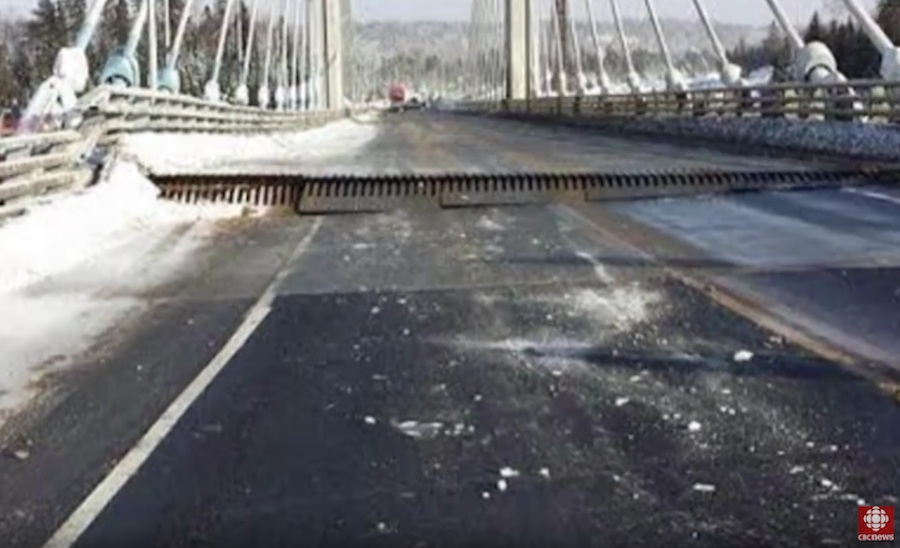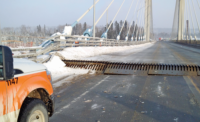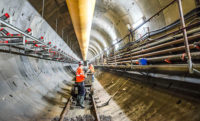Transportation officials in Ontario believe that 40 bolts securing the deck to beams on one span of the two-span new Nipigon River Bridge, 60 miles from Thunder Bay, Canada, failed under uplift forces from the bridge cables, which pulled the deck up several feet. That opened a breach in the roadway that halted traffic on the heavily used Trans-Canada Highway.
No injuries were reported and the deck has since been loaded with highway dividers to close the gap.
Designed by Toronto-based MMM Group, the structure was the first cable-stayed bridge in the province. The 252-m-long bridge has spans of the 113 and 139 meters.
According to a description of the bridge deck on a website of Hatch Mott MacDonald, which served as construction contract administrator, the deck is comprised of steel beams and three plate girders with a series of transverse beams supporting the precast concrete deck.
Part of the west span of the new, $106-million bridge displaced upward nearly two feet.
The exact design of the connections involved is unclear. Gerry Chaput , assistant deputy minister in Ontario’s Ministry of Transportation, said the bolts suspected of failing were resisting uplift forces on the shorter west span.
It is too early to say what if any penalties the construction, design and engineering team will face for the issues with the bridge, he said.
Construction Team
A joint venture that built the current bridge spans, Bot Ferrovial, is building another one alongside the existing structure. The venture combines Bot Construction, one of Canada’s largest civil engineering and construction companies, with Ferovial Agroman Canada, part of Madrid-based, global infrastructure giant Ferovial.
Tests on the bolts will begin Monday at two different labs, the National Research Council of Canada in Ottawa and Surface Science Western at Western University.
Transportation officials and their consultants will also be looking at the bolts and once the review is complete they will decide whether to add a counterweight beneath the west span.
“Uplift force is an issue with cable-stayed bridges,” Chaput said.
The split in the bridge immediately stoked speculation in the local media that the severe Canadian cold was to blame.
But the temperature, while cold at 22 C, was well within the range for which the bridge was designed under Canadian bridge codes.
“We can get weather much colder than that,” Chaput said.
However, Mark Green, a professor and associate head of civil Engineering at Kingston’s Queen’s University, said weather fluctuations did in fact pose design challenges.
Dramatic Temperature Swings
The issue is not so much the extreme cold as the dramatic swings between brutally cold winters and short, but relatively warm summers.
Over the course of a year, temperatures in Canada have a range from high to low of 80 deg C, compared to 40 to 50 deg in Europe, where cable-stayed bridges originated in the post-World War II years.
Green speculated that low temperatures could have played a contributing factor, shortening the cables and contributing to the uplift.
If the bolts were not manufactured as specified, then the issue will fall back onto the supplier, Green said. But if the bolts were delivered with the correct specifications, then the issue will be the specifications drawn up by the designers.
“It all comes down to what they determine went wrong,” Green said.





Post a comment to this article
Report Abusive Comment